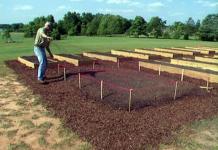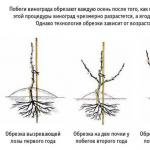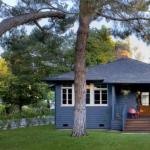The decision to increase the area of a country house or apartment comes in view of the circumstances. I want to finish the kitchen, bedroom, bathroom or a separate area. And the first thing you encounter is the foundation. I would like, of course, to make it qualitatively and reliably.
If the future building is a separate zone, it will be possible to apply the construction of a separate foundation, which makes such a building easier to work with and a more reliable design. You should decide on the type of foundation and make the right choice so that additional problems are not created in the future.
Choosing the type of foundation for the extension
There are several types of foundations, according to the principle of which, you can build an extension:
- Columnar.
- Pile.
The most universal is the first type. Choosing a tape base, you can use any type of structure, from light buildings to heavy frames. In order to avoid subsidence, a closed-loop base circuit is used.
The columnar base is used in lightweight structures. It is distinguished by its reliability and affordable price. The only downside is that you can't build a basement. Here the basis is the pillars, which should be installed at a distance of 1.5-3 meters. The material for them can be very different: larch beams, brick, reinforced concrete. But the first option is used extremely rarely, as it has a high cost and a short service life.
With weak soil and the use of a massive structure, it is possible to make a pile foundation. These can be steel, reinforced concrete, wooden or asbestos supports, which are connected by a strapping beam.

The main recommendation should definitely be used. It consists, according to experts, in the choice of a related foundation with the old building. If there are different bases, different shrinkages will be observed - this can lead to cracks in the foundation. After all, the interaction of the base with the ground is different for everyone.
A good option for "strong" soil is the choice of a columnar base, in others - pile and tape.
Methods for pairing foundations
There are two ways to conjugate bases:
- Use of technology with rigid reinforcement. This method is acceptable if the building has been standing for at least 15 years and the foundation is well established. And in the presence of non-heaving soils. Other cases are considered inappropriate.
- Use of expansion joint technology. The option is the simplest and most economical. All three types of bases can be used - tape, columnar and pile. Roofing material is mainly used as an insulating material.
reinforced connection
- It is necessary to decide on the type of basis. An identical option with a finished house is selected.
- The parameters are determined: the depth of occurrence and the width, if it is a tape base. With the pile version, the depth is determined and the thickness of the pile. The width is determined by an ordinary metal rod, which will have a right-angled bend at the end. It should be pushed under the base to its end. Then turn the hook vertically and pull back until it stops. This will be the thickness of the base. A notch is made and the rod is pulled out in the same order. The depth of the additional structure is slightly higher - this is given for future shrinkage.
- Holes of such a diameter as reinforcing harnesses are prepared at the base of the house. The length of the rod is calculated as follows, it is necessary to multiply the diameter of the bundle by 35. Their number is taken at the rate of 20 pieces per 1 sq. m. The rods are driven in half the width of the base, left on top for the same length. You can cut them with a grinder or an emery machine. The harness is equipped with a longitudinal section at the end, for the wedging insert. The method used will make the connection of the two bases reliable and durable.
- Further,where the rods are laid, and poured with concrete mortar. After the concrete has completely dried, the formwork is removed, the base is ready.

Expansion joint device
A deformation seam is arranged from the sole of the base and along the entire wall. The step between the seams can be determined using certain calculations. Which are influenced by such parameters as: the functional purpose of the room, the material of the walls, the type of soil, the magnitude of the influencing load.
For example, for wooden structures, the step is 70 m, for brick structures - 15-30 m. If parts of the building have different purposes, then there are compensating gaps at their boundaries. After all, it is in these places that the greatest tension is obtained.
The expansion joint in the base plate can be called a gap that divides the blocks. Fill it with resin impregnated, tow, but the main component of the base -. Compensating seams are also made in it, which will protect it from cracks due to uneven subsidence and movement of the soil.
Then, the function that it performs will be lost. At a distance of 2 meters, seams are arranged and laid with wooden slats. Next, waterproofing is done with various polymers or, for example, hot bitumen. The seam between the bases and the blind area due to the waterproofing finish of the outer wall is movable, which prevents any damage.
Building connection technology
- Preparation.
- Markup.
- Excavation.
- Pillow.
- Formwork.
- Waterproofing.
If a separate base is being built, a gap of 5 cm is maintained. In order to properly withstand it, several layers of roofing material or a board wrapped in film should be applied to the built wall. In the future, all this can be left there and sealed with a decorative finish.
For an additional building on one floor, a gap of 2 cm between the buildings will suffice.
Step-by-step guide to laying the foundation for an extension
Consider, for example, the columnar base of the additional structure:
- Preparation and cleaning of the territory with subsequent leveling.
- The markup is done according to the calculations and plan.
- Wells are being prepared, the depth of which is below the freezing threshold of the soil.
- Sand is placed at the bottom of the hole, filled with water and tamped down, a pillow is obtained.
- Installation of rebar or fiberglass for foundation strength 20 cm above ground level.
- The formwork of the above-ground part is being constructed.
- Pouring with concrete mortar. Climatic conditions, soil features of a given region affect its composition and should be included in the project.
- Waterproofing is done in four layers in turn: bitumen, roofing material, etc. in the same way.
The finished base should be moistened with water or sprinkled with wet sawdust. The moistening process starts 8-10 hours after pouring. This procedure will help the base to dry evenly without cracks, and should be continued for 3 days.

Possible errors and their consequences
- A frivolous approach to choosing a foundation leads to cracks in both buildings.
- Incorrectly determined the depth and filling of the base will lead to freezing and ultimately the destruction of the structure.
- Strength calculated incorrectly. The consequence of this incident will be destroyed walls and numerous cracks.
How to avoid them
- To avoid violating the choice of the type of base, it is worth correctly assessing the situation. If the base is tape, choose the same option for the additional building.
- If the base is not deepened correctly, the entire perimeter of the base should be poured.
- In case of loss of strength, a major overhaul should be made.
The sole is made a little higher than the main building, a place is given for shrinkage.
If the side of the additional building is within 3 meters, you can dig out the entire length, but if more, it’s not worth it. Possible weakening of the base and stability. Then you have to do its repair, and not complete the extension.
The best approach before construction would be if the base is poured in the fall, and construction begins in the spring. During this period, soil shrinkage will occur.
The construction of an extension should be treated as the construction of the main building. High-quality construction will not allow both buildings to collapse. Waterproofing should be made with an effective material, for example,. Get the right reinforcement.
If you follow the advice in your work, then you will be provided with high-quality and reliable housing.

A house built with wood is not only beautiful. Housing is considered environmentally friendly and does not cause any harm, and the emitted essential oils contribute to easier breathing and have a positive effect on the psyche. And if during the construction all technological recommendations were met, then such a house will delight its owners with an excellent performance.
But time passes, and it happens that a small wooden house no longer satisfies with its parameters, and this leads to discomfort. In this case, a decision is made to expand the space. You can solve the problem with the help of an extension.
There is one golden rule in construction that should not be broken or ignored. Its essence is that the construction of an extension follows from the material with which the house was built. This was due to the fact that the market was not saturated with a special variety. There you could find only brick, cinder block and clay.
But fortunately, technological progress does not stand still, and the building materials market offers many options. Their choice largely depends on the financial capabilities of the consumer, as well as on his individual preferences. Therefore, today the golden rule can be grossly violated.
When choosing a material for an extension, brick or blocks should be preferred. The main difference between them is their properties and quality. The final decision must rest on these two factors, and it must be taken into account.
Brick is a good material. Has its own advantages:
- characterized as strong and durable;
- refractory;
- conducts heat;
- resistant to temperature changes;
- quite static;
- has good sound insulation.

But taking into account the fact that it will have to be laid out in several layers, it will cost the consumer a tidy sum. It is also worth considering the fact that the brick is a fairly cold material. To achieve the most comfortable temperature conditions in the extension, it will be necessary to insulate the facade of the walls. And this plus additional costs.
Important! If during the construction work all technological recommendations regarding brickwork were met, then the extension can serve its owner for many years.
A brick will require a reliable and durable foundation that can withstand the entire load.
It is worth paying attention to the cinder block. This material has a number of advantages that distinguish it from many others. The most basic plus is that its pricing policy varies within low prices.
Due to its size, the number of required blocks is several times reduced compared to a brick. The porous structure helps to retain heat inside the room, which means: you do not have to additionally insulate the walls.
Important! The material does not contain toxic substances. Eliminates the risk of mold or other dangerous fungus. Not interested in rodents and insects that could settle in it or somehow damage it.

The foundation for the cinder block requires an insignificant, shallow depth of up to 0.5 meters. This is due to its lightness and relatively low weight.
Building without a foundation: is it possible?
In fact, experienced builders and craftsmen are sure that any building needs a reliable foundation, if the owner wants it to last for many years. Its absence entails the destruction of the walls in the future, which can float. Cracks will actively form due to the difference in soil levels, and this will entail damage and additional costs.
But if the extension is made according to the principle of a loggia, then it is possible that the work will end in success. In any case, it is worth seeking the advice of an experienced specialist.
Over time, some private buildings require expansion for various reasons. For example, an increase in the number of people sitting, sewerage into the house, or the need to close the front door from direct cold. Therefore, there is a need for an additional room, expanding the kitchen, arranging a room for a bathroom, or simply building a veranda.
An extension to the house with your own hands can be made of wood, brick, or in a combined version, which includes several building materials.
Requirements for premises
In order not to have to make additional changes in the attached room, it is better to immediately think through all the nuances of the extension, since each of them requires a special approach.
Extra room
If you want to add another living room to the house, you will have to try, since this work is almost tantamount to building a small house. The floors, walls and ceiling of the building must be well insulated, otherwise the heating provided to it will not be effective - this is one of the main conditions for a dwelling. The second important condition for normal living is the absence of dampness in the room, which means that reliable waterproofing is needed.
Kitchen or bathroom
When arranging these premises, before installing the foundation, engineering communications are brought to the construction site - in particular, sewer pipes. You may have to separately conduct and plumbing.
In addition, it is also worth paying attention to the insulation of all elements of the structure, to think about reliable waterproofing of the floor.
Veranda
A veranda is a light structure that serves mainly to protect the main entrance to the house from wind and rain, or is used for summer holidays. It can be closed, have a door and one or more windows, and May be and completely open, that is, it is a flooring, low walls and a roof raised on pillars.
This building does not require special insulation, but you still have to carry out waterproofing for the foundation.
Foundation for an extension
The foundation for an extension can be tape, lined with brick or stone blocks, or columnar. Each of them has its own advantages and disadvantages. To stop at one of them, you need to find out how each design is arranged, and choose the one that is more suitable for a particular extension.
Information about the construction of the foundation
Strip foundation
So, the strip foundation is arranged in the following sequence:
- First you need to mark up and trace the place where the extension will be placed. This is done with a rope that is stretched across the terrain and secured with pegs.

- Further along the markup, a trench is dug to the same depth as the foundation of his house is built. It would be nice to fix the reinforcement connecting the foundations of the main building and the extension before pouring concrete.
- The width of the trench should be 100–150 mm greater than the planned wall thickness.
- After the trench has been dug, it is further prepared. First, backfilling at the bottom of a sand cushion with a thickness of 100–120 mm is carried out. It must be carefully tamped.
- The next layer is covered with crushed stone or broken brick, which is also compacted with a manual rammer.
- Further, along the entire perimeter, waterproofing is laid in the trench, which should extend to the soil surface by 40–50 cm, since it should cover not only the inner part of the foundation, but also the formwork for its above-ground part.
- A welded reinforcing structure is installed on the waterproofing film, which must repeat the shape of the foundation, and to its entire height.
- Then the reinforcement is poured with a rough concrete mortar of cement and gravel, to ⅓ of the height of the trench, and after this layer has hardened, the next one is poured - to one second of the remaining height.
 Installation of formwork for strip foundation
Installation of formwork for strip foundation - After pouring this layer, you can start building a wooden formwork to form the above-ground part of the foundation - the basement. The waterproofing film is left inside the formwork, straightened along its walls and fixed on top of them so that it does not slip into concrete.
- Concrete is poured into the prepared formwork to the top. Then the solution is pierced in several places with a shovel so that no air cavities remain inside it. You can lightly tap on the formwork - this vibration will help the concrete to compact as much as possible.

- After completing the pouring of the foundation, the concrete is leveled to the required level and left to dry, sprayed daily with water to harden.
- After the final hardening of the concrete, the formwork is removed and the foundation is waterproofed from the outside.
- Before starting the construction of walls, it is recommended to additionally cover the foundation with waterproofing compounds or roll materials. For this process, liquid rubber, tar, bituminous mastic and roofing material are used.

- The space inside the strip foundation can also be equipped in different ways - with a concrete screed or flooring from floor beams and a log with a wooden floor on them.
Video - building an extension to a house on a strip foundation
Column Foundation
In addition to the strip foundation, a columnar foundation can be arranged, which is built from brick or concrete, as well as a combination of these materials. Basically, this option is used for the construction of verandas or additional living rooms, since communications associated with water supply or sanitation in an uninsulated or even open underground will require additional thermal insulation.

A columnar foundation is most often arranged if it is planned to mount a boardwalk.
The work is carried out in several stages:
- The first step is marking the site selected for the extension. The pillars should be at a distance of one and a half meters from each other.

- Pit pits are dug for each pillar separately. Their depth should be 500-600 mm, with a square side of 500 × 500 mm. To the top of the pit should expand somewhat - by about 100 mm on each side.
 Installation diagram of the foundation pillar
Installation diagram of the foundation pillar - Next, the bottom is strengthened in the same way as when constructing a strip foundation, using sand and gravel, waterproofing is laid.
- If the pillars will be built of brick, it is recommended to lay a layer of coarse cement mortar on the bottom. Only after waiting for it to harden, they make brickwork.
- If the pillars are concrete, a reinforcing structure and formwork are installed at the bottom of the pits to the height of the future pillar. The waterproofing film is allowed inside the formwork and fixed on top of it;
- Concrete is poured into the formwork in layers. Each layer must set well before the next is poured;
- The top of the column is well leveled and sprinkled daily with water until completely solidified;
- After the pillars are ready, the formwork is removed from them and they waterproofed roofing material, which is glued to heated bituminous mastic.
- In the gap remaining between the soil and the pillars, backfilling is done, tamping every 100-150 mm of the backfilled soil mixed with crushed stone.
- Several layers of roofing material are laid on each of the pillars - it is necessary for waterproofing the wooden bars that will be laid on top of the pillars.
Extension floor base device
If a strip foundation is chosen, both a wooden and a concrete floor can be arranged on it. A columnar foundation without lintels suggests a wooden floor.
Concrete floor
To make a reliable and warm floor screed inside the strip foundation, you need do work step by step, adhering to a certain technology.
- To begin with, excess soil is selected inside the finished strip foundation. It is first loosened and then removed to a depth of approximately 250-350 mm.
- At the bottom of the resulting pit, a sandy ten-centimeter pillow is poured and compacted. Crushed stone can be laid on top of it, but instead of crushed stone, expanded clay is used to insulate the screed, poured in a layer of 15–20 cm.

- Expanded clay is leveled, and a reinforcing grate is laid on it. After its installation, a beacon system is arranged from above along the selected horizontal level. Some rooms, such as a bathroom or an open terrace, may also require a certain slope of the surface for unhindered flow of water that has fallen on the floor to the drainage system.
- Next, a cement mortar is laid out on the prepared surface and leveled using the rule. A day later, it can be covered with plastic wrap - then the concrete will mature more evenly, which will give it additional strength.
When the walls of the extension are erected, any decorative coating or a wooden floor can be laid on the resulting concrete base.
Floor on wooden beams
- Floor beams are wooden bars of a sufficiently large thickness, about 150 × 100 mm in cross section. You can’t save on them, since the overall strength of the floor will depend on their reliability.

- The beams are laid on poles or strip foundations, on top of the made roofing felt substrate, and can be fixed to concrete in various ways - using through fasteners, corners and other metal devices. Between themselves, the beams at the intersections are also fastened with powerful corners.

- They will hold securely, as the wooden flooring of the "black" and "white" floor also serves as a kind of binding fastener.
Video: erection of a frame extension with a wooden floor
Construction of extension walls
Brick or frame walls can be built on a ready-made strip foundation, while a columnar one is mainly used for frame buildings. If it is planned to make brickwork on the pillars, then additional concrete lintels will have to be made between the pillars.
Frame walls
- The frame for future walls is erected from a bar and fixed to the crown beams of the ceiling that were mounted earlier. The beams can be attached to the beams separately, but sometimes it is much more convenient to assemble the wall elements in a horizontal position, on a flat area, and then install them in a vertical position already assembled.

- To connect the frame to the wall of the house, perfectly accurate vertical markings are made on it, along which a separate bar or assembled frame element will be fixed.

- For reliability, all the bars are interconnected by metal corners.

- Having installed the entire frame of the extension, it is better to immediately sheathe it with boards or plywood (OSB) from the outside. Sheathing will immediately make the structure stiffer.

- The upper horizontal beam, running along the house, is attached to the main wall using reliable metal corners or anchors.
- The walls are insulated after the roof is installed.
Video: another example of building a light extension to the house
brick walls

- Before you start building brick walls, you need to carefully check the horizontalness of the foundation surface and, if necessary, align it to the ideal. If the base is uneven, then the masonry may crack from deformation during shrinkage.
- It should be noted that brick extensions are best done to also a brick house. To connect the extension with the main wall, during the construction of the walls, holes are drilled two-thirds of the depth, through every two to three rows of masonry. Reinforcement is embedded in them, which should protrude from the wall by about half a meter. It should be in the seams of the future masonry. So that the seams on these rows are not excessively wide, the reinforcement should not be chosen too thick, or it will be necessary to make a recess in the bricks of the row on which the reinforcement will be laid.
- If a brick extension is arranged against a wooden wall, then a hole is drilled through it, into which reinforcement with a transverse stopper is installed from inside the house, which will hold it in the wall. Reinforcement is also installed as the wall is erected, every two or three rows.

- Before starting laying, a twine is stretched along the future wall, along which it will be easy to control the horizontal rows, and the verticality is constantly verified with a plumb line.
- The thickness of the walls will depend on what function the extension will perform. If this is a living room, then laying should be done, at least one or two bricks. If the room will play the role of a veranda or utility room, then half-brick laying will be enough.
- Having built brick walls, they are tied around the top with a concrete belt. Formwork is made for it, a reinforcing structure is laid in it and poured with concrete mortar. After the solution has completely solidified, the formwork is removed from the belt, and you can proceed to the flooring device.
It should be noted that building brick walls is not as easy as it seems, therefore, if there is no experience in this work, it is better to entrust this process to a qualified bricklayer or choose a different type of wall.
Covering the extension and roofing
After the walls are erected, it is necessary to make a ceiling. For it you will need bars - beams, which are installed on the upper part of the walls, at a distance of 60-70 cm from each other, and fixed with special corners.
If the beams are laid on a brick building, they can be embedded in a concrete belt, after wrapping the edge of each of them with roofing material.

The next step is the filing of the beams with boards or thick plywood, on which a heater will be laid on top, between the beams.
The roof of the extension can have different designs, but basically a shed option is chosen, which is worth considering.

- This design consists of rafters on which the roof is laid. This type of roof is arranged quite simply, the main thing is to choose the right slope angle. It must be at least 25 — 30 degrees - this is necessary so that precipitation does not linger on the surface in winter, otherwise they can simply damage it.
- Having determined the slope angle, a mark is made on the wall or front part of the roof in the form of a horizontal flat line, along which the bar supporting the rafters in the upper part will be attached. The lower support for them will be the previously laid floor beams or the edge of the wall. The rafters must extend beyond the boundaries of the constructed walls by 250 — 300 mm, in order to protect the walls from rainwater as much as possible.
- The rafters are also fixed with the help of metal corners.
- It will be more difficult to solve the issue of the slope of the roof if the extension is installed on the side from which the slope of the main building of the house is arranged, since there will simply be nothing to fix the cross beam there. Therefore, you may have to remove several lower rows (sheets) of roofing material from the roof of the house in order to use its beams to secure the truss system and unify the overall coverage.
- It is necessary to decide in advance which roof will be laid on top of the truss system. If it is a soft roof or flexible tiles, then solid material is laid and fixed on top of the rafters, for example, plywood or frequent transverse lathing.
- If large canvases are fixed (roofing iron, metal tiles, slate, etc.), then they can be overlapped with directly installed rafters.
- When the system under the covering material is ready, it is recommended to lay waterproofing on it. In the first case, plywood is covered with it, in the second, it is fixed to the rafters.
- Roofing material is laid on top of the waterproofing material, starting from the bottom of the truss system and rising up. If it is necessary to combine the roof, then when docking, the top row of the roof of the extension is slipped under the last row of the roof slope of the main building.
- If the roof adjoins the upper part of the roof to the wall or the frontal part of the roof, then the joint between them must be waterproofed.
- When the roof over the erected extension is ready, you can begin to insulate the walls and floor.
Prices for metal tiles
metal tile
Insulation of the extension from the inside
If the room is residential, then reliable thermal insulation is indispensable. If the ceiling is already sheathed and insulated, then you can proceed to the insulation of the floor.
Floor insulation on beams
If floor beams were installed on a columnar foundation for the floor, then the work proceeds as follows:
- Transverse logs from smaller bars are fixed to the floor beams.
- It is recommended to arrange a draft floor on the logs, in this case it is better to lay the boards for it with a continuous flooring, otherwise the heat from the house will be blown out.

- Further, the entire rough coating is smeared with a sufficiently thick clay solution, and after drying, a vapor barrier film is laid on it.
- Mineral wool is tightly laid between the logs, expanded clay or slag is poured.

- From above, the insulation is again closed with a vapor barrier, and a wooden floor is laid on it from boards or plywood.
- A decorative coating can be immediately laid on the plywood, or an infrared film floor can be arranged under it.
Concrete floor
The concrete floor can be insulated as follows:
- Mineral wool laid between logs fixed on a concrete base and then closed with boards or plywood.
- One of the "warm floor" systems (electric or water), which fits into the final leveling screed;
- Infrared film laid on a thin thermal reflective substrate, and closed with a decorative coating;
- dry screed and gypsum fiber plates.
When the floors are insulated, you can proceed to the thermal insulation of the walls.
Frame walls
- Mineral wool produced in mats is used for internal wall insulation. It is convenient to lay them between the bars of the frame. This work is simple and is done quickly enough.
- When the walls are covered with insulation, it is tightened with a vapor barrier film, fixing it on the bars with brackets.
- Then the wall can be covered with natural wooden clapboard, OSB boards or plywood, drywall or GVL - there are a lot of options, there are plenty to choose from.

Expanded polystyrene can also be used as a wall insulation, but its environmental and operational qualities are much worse than those of high-quality mineral wool.
brick walls
Brick walls are usually finished with plaster or drywall from the inside, and insulation is carried out from the outside, but they do it differently.
Insulation, if space permits, can be carried out in the same way as in a frame building, fixing bars on the walls and laying mineral wool between them, and then closing the structure with plasterboard slabs. Wallpaper or any other decorative material can be glued to this coating.
To do everything right, you need to study in detail each stage of the construction of the extension and adhere to the developed technologies. If there is no confidence in one's abilities, there is a clear lack of skills and experience in construction, it is better to entrust this rather difficult work to qualified craftsmen.
An extension to the house is an independent structure, the installation of which is possible in two ways.
With proper thermal insulation, a constant temperature is maintained in the frame extension for up to 7 hours.
The first way is the simultaneous construction of an extension to the house with the main frame. Its advantage is that with such an erection there are no problems with joining the walls of the two foundations, the main room and the extension. The second way is to complete the construction of a new room to the frame of an already finished house. Whatever method you use, it is important to make the foundation for the extension in accordance with all reliability requirements. Both bases closely interact with each other. Therefore, before pouring the foundation for an extension, it is important to obtain the following information:
- the type of foundation of the house to which the extension is planned: the level of laying, construction, area and step of the columnar foundation, the width of the sole, if the foundation is strip;
- type of construction site soil: type and physical and mechanical, their design resistance at the base of the structure, heaving properties within the freezing depth.
How to determine the characteristics of the foundation of the house in the absence of construction documentation?

An example of a diagram of the inner wall of an extension.
If the documentation confirming the characteristics of the building has not been preserved or, which often happens, it has not been kept at all, then additional efforts will have to be expended to determine. In this case, it is necessary:
- dig a hole to the depth of the foundation at the junction of the extension;
- determine its type, width, possible presence of a sand cushion;
- determine the parameters of the supporting part of the foundation of the house;
- take soil samples for laboratory analysis and determination of its physical and mechanical characteristics, the calculated resistance of the base of the foundation and the degree of heaving of the base.
To determine the width of the tape base, a steel rod with a hook bent at the end in a horizontal position is hammered under its sole. Then the rod is turned so that the hook is in a vertical position, tightened back until it stops and a mark is made on the pin. After that, the hook is again deployed horizontally and pulled out from under the base. The width of the tape will be equal to the length of the marked part of the rod. Based on the above data, a decision is made on the type of construction of the foundation of the extension and the method of their connection with the foundation of the house.
Back to index
Definition of Reliability

The reliability of the foundation is an equally important parameter for both the main structure and its extension. So, in non-rocky soils, where the penetration does not depend on the depth of freezing, the reliability of the foundation is ensured when the parameters of the supporting part are calculated based on the load of the structure and the resistance of the soil at the level of its inception. The precipitation of the base in such soil, if these conditions are met, will be within the normal range. Practically non-rocky soils are gravelly, high and medium-sized sands and coarse-grained soils. During construction in such conditions are usually negligible. They stop immediately after the completion of construction work. A structure erected in heaving soils can be considered reliable if:
- in calculating the dimensions of its supporting part, parameters such as the load of the house and the resistance of the soil under the sole of the foundation are involved;
- the deformation of the heaving of the foundation under the influence of tangential forces during the freezing of the soil at the calculated depth is zero.
A deep foundation in heaving soils allows only deformation of the sediment. The reliability of a shallow foundation in heaving soil is ensured if three conditions are met:
- the parameters of the support are determined from the calculation of the structural loads and the resistance of the sand cushion or the soil underlying it;
- freezing of heaving soil at the depth of the foundation does not lead to heaving deformation under the influence of tangential forces;
- heaving deformation during freezing of heaving soil below the base of the foundation does not exceed the permissible limits.
Back to index
Options for adjoining the base of the extension to the main structure
To make the foundation of an extension, you need to know two options for adjoining it to the foundation of the main structure.
The joints of the foundation of the house with are made in two ways:
- Rigid connection with reinforcement.
- Expansion joint.
Back to index
How to make a foundation with a rigid base connection?

A rigid connection is often used on soils that are not subject to heaving.
A rigid connection is used mainly in low-rise construction, where the extension is functionally connected to the main structure, being under the same roof with it. To make a base for an extension, a hole is drilled in it with a diameter equal to the diameter of the reinforcement and a depth equal to about 35 of its diameters. Further, reinforcement is hammered into it with a release of the same length. If the extension is carried out according to the scheme where the estimated length of the reinforcement is greater than the width of the foundation, then the holes in the foundation of the main structure are made for a part of the width, and the reinforcement is mounted according to the anchor principle, with a wedging insert at the end.
With a closed loop, the holes are drilled in a checkerboard pattern in two levels, and the reinforcement used has an anchor wedging at one end, and a welded washer at the other end. The amount of reinforcement, its pitch and diameter are calculated based on the conditions of its lowest resistance to shear and crushing of concrete under it. On average, a closed loop of a new foundation will require 20 rods per square meter of foundation. They are cut with an emery machine or grinder. With an open circuit, the number of reinforcement bars is calculated separately in each case and depends on the width of the future foundation.
A rigid connection is used when the recessed tape base of the house and the extension is made of monolithic reinforced concrete, and with a shallow type of foundation, the plinth and foundation form a single monolithic structure. and plinths do not provide a reliable connection, and with a columnar foundation, a rigid connection is possible, provided that the height of the monolithic grillage is enough for the installation of anchors. The slab foundation allows a rigid connection, provided that there is a protrusion from the base not less than the thickness of the slab. In this option, you can expose the reinforcing cage of the house and connect it (weld, tie) with the reinforcement cage of the extension. A house with a basement floor can be connected to a basement-free extension with a rigid link if the basement of the main building and the recessed walls are monolithic.
Use of expansion joint

Expansion joints are more often used in multi-storey residential and industrial construction, where under a long structure in its different parts, the soils differ significantly in deformation characteristics and, under the same loads, precipitation can differ significantly. Such seams are used at different heights in different parts of the structure, thus giving different loads and different deformations of the sediment. Another case of using expansion joints is when another structure is closely attached to an existing structure. In the above options, expansion joints should be provided at the design stage. Often, expansion joints are easier and cheaper to apply when in heaving soil.
The expansion joint is a heater placed in the gap between the walls and basement ceilings, without coupling with structures. Often a simple tow is used as such a heater. The junction is fenced with a decorative overlay attached only to the wall of the house. In heaving soil, when using an expansion joint, the floor level of the extension is placed below the floor level of the main structure by the amount of expected deformations.

The filler is removed from the zone of the expansion joint to a sufficient depth for laying the sealant.
What should be considered in order to make a foundation for an extension using an expansion joint:
- the gap between the bases of the extension and the main structure should be about 5 cm. To comply with this requirement, before making the foundation of the extension, boards covered with waterproofing are applied to the base of the house. They will play the role of an expansion joint in the future;
- for a one-story extension of small dimensions, the thickness of the expansion joint can be 2 cm;
- the seam can also be filled with thermal insulation material (styrofoam or polystyrene foam is best) and sealed with a weather-resistant sealant. Outside, it is closed with a decorative overlay.
Time passes, and it turns out that a private house no longer satisfies the owners with its size and amenities. A decision is made to expand its area with an extension. We will tell you how to do it efficiently and at no extra cost in the article.
Save money without sacrificing quality – room requirements and materials
Poorly thought out extension design will eventually force something to be redone or completed, attached to the country house. In order not to get into such a situation, we think through all the nuances, weigh the advantages and disadvantages of our idea. We start with the choice of location and size.
Each type of additional room has its own specific features in connection with the use, requirements for insulation, waterproofing and others. If a decision is made to build an additional living room in the country, then this is tantamount to building a small house. It is required to reliably insulate, to prevent the appearance of dampness. If you plan to stay in cold weather, you need to think about heating.
Another common type of outbuildings are kitchens and bathrooms. The requirements for them are practically the same. First of all, we think about engineering communications and sum them up even before the start of construction. Sewer pipes, water pipes are much more convenient to lay before pouring the foundation than to make their way under it later. Increased attention requires waterproofing flooring. We are thinking about warming, but if the kitchen is planned for summer, then this can be saved.
Expand the house and an extension of the veranda. The structure is light, serves for summer holidays, protects the entrance from wind, snow and rain. It is carried out in many versions: from the simplest in the form of a boardwalk, low walls with a roof on pillars, to a complex one with walls, a door, windows. No insulation is required, otherwise it will no longer be a veranda, but foundation waterproofing is necessary.
An extension to the house should be in harmony with the main building. If the house has an exterior finish, then it will not be difficult to repeat it on the attached premises. With all materials, wood is well combined, which looks great even without additional finishing. The best option would be a frame structure:
- built quickly, in just a few months;
- does not require a capital foundation, because it is light;
- without special knowledge and skills, it is available for construction with your own hands;
- will cost less.
The base for the extension is made on the same level as the foundation of the house. When attaching the structure to the house, we do not do it tightly - over time it will shrink - but leave an expansion joint. In this regard, frame structures, which do not give vertical shrinkage, compare favorably.
If the structure is attached to the front wall, the roof continues the main roof and is made single-pitched. We choose the slope in such a way that the snow does not linger and the rain flows down. If this is an extension to the side wall, then the roof repeats the configuration of the main one. The roofing material is the same as on the roof of the house, if different, it is important that they are combined.
Pillar base - fast, cheap, reliable
For the columnar foundation of an extension to the house, concrete, brick, or a combination of both is used. It is done mainly for a living room or a veranda. If applied to a kitchen or bathroom, thermal insulation of the entry of utilities into the house will be required. Since protection concerns an average of half a meter of pipes, you can go for such expenses, it will still come out cheaper than a strip foundation. The floor is made of boards, for concrete you will need a lot of material for backfilling, a fence around the perimeter.
We start with the marking of the site, the installation sites of the pillars are one and a half meters from one another. A separate pit 50 × 50 cm is dug under each pillar, with a depth greater than the freezing of the soil. At the top, we expand the pits a little: about 10 cm on each side. We fill the bottom with a layer of sand of 10 cm, carefully ram, then crushed stone or broken brick, which is also rammed.
We lay out the film for waterproofing, bring the ends to the surface. If we plan to build brick pillars, we pour a little concrete mortar for the base into each pit and wait for it to set. When concrete pillars are planned, we tie the reinforcement at the top along the entire height, lower it into the pits. We provide an equal distance between the walls. We put pieces of brick under the bottom to raise the reinforcement by about 4 cm.
We make formwork for the plinth, inside which we launch the film. Concrete is poured in layers, each layer is pierced several times with a bar so that air bubbles come out. It is important not to rush, it is better to wait until it seizes, then continue pouring. We carefully level the top of the column and wait about two weeks until the concrete hardens. All this time, pour heavily with water, cover with burlap or film.
When the foundation has gained the desired strength, the formwork is removed. We heat up the bituminous mastic, apply it to the poles and immediately glue the pieces of roofing material for waterproofing. Between the pillars there was a space that it is desirable to fill up in order to insulate the floor. We use ordinary earth mixed with rubble or pieces of brick. We fall asleep in layers of 10 cm, we ram. The technology for erecting a strip foundation is practically no different, but unlike a columnar one, it is solid.
Getting started - lower trim and extension floor
So, we settled on the frame version as the fastest and cheapest. In order for a tree to serve for a long time, it is required to adhere to two rules: make reliable waterproofing and carry out antiseptic treatment. Of course, the wood must be well dried. For waterproofing, the most reliable means is bituminous mastic. It is possible to use several layers of roofing material, but it is short-lived.
Then we make the bottom strapping. Usually a beam of 150 × 150 mm is used, but boards of 150 × 50 mm can be used. We lay them horizontally around the entire perimeter, leveling with the outer edges of the foundation. We do not connect the boards of the first row to each other. The second row is laid on top, overlapping the joints in the first.
In the boards laid in this way on the foundation, we make through holes for the studs and connect them. If it is tape, we drill and connect on the ground, and then lay it. To get the effect of a single beam, we knock it down with nails in a checkerboard pattern after 20 cm. It turns out a strapping of the desired thickness, which also has additional advantages:
- is much cheaper than bars;
- it is very easy to connect with each other, with bars it is more difficult.

We attach the lower trim to the beds from the same boards 150 × 50 mm, installed on top of the edge along the outer edge. We fasten them together and with the beds with 90 mm nails. Next, we expose the logs from a similar material installed on the edge. The distance between them is 60–80 cm, but it all depends on the size of the frame extension: the longer the logs, the already we install them. They are attached to the binding board with nails, 2 on each side.
Now let's move on to floor insulation. The cheapest, though not very environmentally friendly option is tiled polystyrene foam with a density of at least 15 kg / m 3. Its advantage is that it is the only one of the heaters that is not afraid of moisture. We nail 50 × 50 mm bars to the lower edges of the log, which will hold the polystyrene foam. A thickness of 15 cm is required: we use sheets of 10 and 5 cm. We lay it so that the seams of the lower and upper rows overlap.

The base is ready. We lay the subfloor on top. So that it does not warp over time, we lay it, alternating the direction of the annual rings. We look at the cut: we put one board with an arc up, the other - down. We make the finishing floor from plywood, the joints are apart. A rough base is not necessary in the presence of edged tongue-and-groove boards with a thickness of 30 mm or plywood 15 mm. We lay directly on the lags.
Wall mounting - two assembly technologies
There are two technologies for assembling frame structures. The first is called frame-panel, when the entire assembly is carried out on the ground, then the finished structures are installed in place and fastened together. Sometimes the frame is sheathed immediately, which makes it even stronger. Another method involves gradual installation right on the spot. Which is more convenient - everyone decides for himself. The shield assembled on the ground cannot be lifted alone; helpers will be required.
We begin the construction of the frame with corner posts. For them and intermediate racks, we use a beam of 150 × 150 mm or even 100 × 100 mm. The distance between the racks is determined by the width of the insulation, which we find out in advance. We arrange the pillars so that the gap between them is 3 cm narrower than the width of the insulation. So we will save on waste-free use of the material and improve the quality of insulation without leaving gaps.

Fastening can be simply and reliably carried out with metal corners installed on both sides of the racks and fixed with stainless screws. Before finally fixing the rack, we carefully check its verticality, this is especially important for corners. One incorrectly set beam will cause the entire extension to bend.
Temporary cuts, which are installed from the inside and serve until the outer skin is attached, help maintain the correct shape of the frame. If the sheathing is made of a hard and durable material such as plywood, OSB, GVK, it is able to independently strengthen the base, which will stand securely after removing the temporary cuttings. When soft material is planned for sheathing: siding, lining, then permanent braces cannot be dispensed with. It is better to install them two at the bottom and at the top of each rack.

In the places where windows and doors are installed, we fasten the crossbars. We make the racks next to them double: they experience increased loads and should be stronger. The final fastening of the frame is carried out by installing the upper trim. In order not to invent anything, it can be similar to the bottom one: beds made of two boards fastened together and the actual harness made of the same boards installed on the edge. To it in the same way as the floor logs were attached, we nail the floor beams from the boards 150 × 50 on the edge with nails.
We constantly check the geometry of the entire structure, as well as the correct installation of racks and crossbars: the racks are strictly vertical, the crossbars are horizontal.
Shed roof - design and implementation technology
The roof of the house with an extension consists of two parts, which should be harmoniously combined into one. If the extension is built on the side, the roof will be a continuation of the main one, it remains only to repeat its design in order to lengthen it. When an attached building is located along the length, its roof is made single-pitched. The slope is provided by the difference in the height of the front and rear pillars. The height of the rear ones should ensure that the roof of the extension goes under the main canopy.
The roof is supported by rafters, which are laid on the beams. They are made of thick boards, to ensure fixation, we make special grooves. We cut them on the ground according to the template so that they are all the same. Then, after installation in place, it will not be necessary to align horizontally. We process the grooves with mastic, install and fasten to the walls with brackets, metal corners on studs. If the length exceeds 4 m, we install additional vertical supports.

We lay the crate on top of the rafters. Depending on the roofing material, we make it solid or in increments of 0.3–0.6 m. The need for a solid wooden flooring arises when soft material is used, we make a sparse one for all other types of roofing. We make fastening depending on the type of roof. We fasten profiled sheets and metal tiles with special self-tapping screws with sealing washers, ondulin - with nails with a wide hat. We provide wave overlap. Don't forget about the final design: the wind strips not only protect the roof, but also give it a finished look.
Warming is a mandatory operation for an extension
For the insulation of buildings, mainly mineral wool and polystyrene are used. Mineral wool resist fire, low thermal conductivity. They have a small weight, a form of release convenient for consumers: rolls, mats. Another popular insulation is foam. Its advantages: it is inexpensive, it is not afraid of fungus, moisture, decay. But there are two big drawbacks: it is very fond of rodents, it releases toxic gases in case of fire.

Warming from the inside is carried out in the following sequence:
- 1. We mount the waterproofing, having previously cut the strips of the required dimensions. We fasten with staples using a construction stapler in such a way as to ensure an overlap. We sheathe the frame completely, driving in staples every 10 cm.
- 2. We lay the insulation between the racks. We provide a snug fit to wooden structures, close the seams between the individual elements of the insulating material, overlapping the next layer.
- 3. We fix the vapor barrier, even if we use foam. The fact is that it is necessary to protect not only the insulation, but also the tree. Fastening is carried out similarly to waterproofing.
- 4. We sheathe the walls from the inside. We use drywall on a perfectly even frame or OSB, if there are irregularities. It is more rigid and smoothes out flaws.
Remained interior and exterior decoration, which provides room for the imagination of the owner. The frame extension is built quickly, cheaply, has been serving for decades, and it can be built with little or no outside help.

















